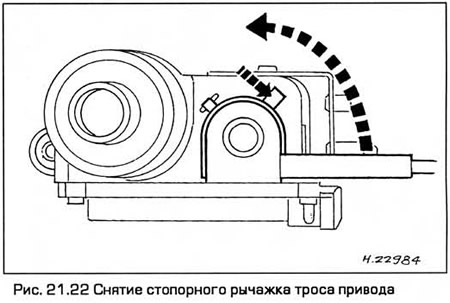2. The layout of the system components is shown in fig. 21.2. The system operates in the speed range from 40 to 200 km/h.
 Pic. 21.2. Speed Control System Components (shown for left hand drive models).
Pic. 21.2. Speed Control System Components (shown for left hand drive models).
1. Electronic speed control device
2. Vehicle speed sensor
3. Throttle actuator
4. Interrupt relay (only for models with traction control)
5. Microswitches for brake light, brake and clutch pedals
6. Steering wheel switches activated by the driver
3. The system contains an electronic speed control device with a built-in actuator and a micro switch installed in the engine compartment. The built-in actuator of the electronic device is connected by a cable to the throttle actuator. The system also contains switches that turn on the driver, brake and clutch pedal microswitches, an indicator and a vehicle speed sensor.
4. Driver-activated switches are located on the steering wheel and are designed to control various functions.
5. A vehicle speed sensor mounted on the transmission provides AC voltage pulses to the electronic speed control device. On early models, the sensor is connected to the speedometer drive cable. On later models, the electronic speedometer directly senses the signal from the speed sensor.
6. Brake light micro switch, brake pedal micro switch and (in the presence of) The clutch pedal microswitch is designed to disable the speed control circuit. The brake light microswitch is activated when the brake pedal is gently pressed, and the brake pedal microswitch is activated when the pedal is pressed hard.
7. During the operation of the system, the indicator displayed on the instrument panel lights up.
8. The procedure for removing system components is described below. Disconnect the negative battery cable before doing any work (chapter 5A paragraph 1). Install in the reverse order of removal.
Microswitches mounted on the steering wheel
9. Remove airbag (paragraph 28).
10. Disconnect the electrical connectors, remembering their position and the position of the wiring (see fig.21.10,a-c).



11. Then unscrew the screws and remove the microswitches (see fig.21.11).

12. If needed (e.g. to access the horn switch), contact plates and springs can be removed from the switches by unscrewing the screws.
Microswitches under the brake and clutch pedals
13. Remove the lower panel located under a steering column from the front panel.
14. Disconnect the electrical connectors of the micro switches of the clutch pedal, brake pedal and brake light (see fig.21.14).

15. To remove the clutch and brake pedal microswitches, turn them counterclockwise. To remove the brake light microswitch, unscrew it clockwise (see fig. 21.15).

16. Installation - in the reverse order of removal. In order for the brake pedal microswitches to function correctly, reset the microswitches by pulling out the plungers completely (see fig. 21.16). Depress the pedal so that the distance between it and the support bracket is as specified in chapter 9. While holding the pedal in this position, secure the microswitch firmly and slowly release the pedal until it reaches the stop. This automatically sets the position of the microswitch.

Speed control actuator
17. On models with 4-cylinder engines, remove the air cleaner (chapter 4).
18. Disconnect the actuator cable from the throttle linkage on the throttle body. To do this, release the tip of the cable from the segment and unfasten the cable sheath from the bracket.
19. On models with V-shaped 6-cylinder engines, disconnect the wiring connector on the top cover of the air cleaner.
20. Disconnect the assembly wiring connector. Turn out a fixing bolt of the executive mechanism. Then pull on the actuator until its locating pins are out of the holes.
21. Remove the assembly. To access the assembly on models with air conditioning, it may be necessary to unfasten and remove the right section of the deflector under the windshield.
22. Press the lock lever on the drive cable cover and remove the cover by turning it counterclockwise (see fig. 21.22).

23. Slowly release the locking lug of the cable (no more than 0.5 mm) and push the end of the cable out of the slot in the pulley.
24. When installing, make sure that the end of the cable is locked in the slot of the pulley.
25. To install the cable cover onto the actuator pulley, hold the cable taut in the pulley groove and pull on the cable end mounted on the throttle linkage to pull the cable cover onto the pulley.
26. To install the cable cover, hold the cable taut and hold the pulley. Then fit the tabs on the cable cover into the slots in the actuator. Rotate the cover clockwise until the lock lever engages the stopper.
Note: Improper installation of the cable on the pulley may result in increased idle speed. After installing the actuator, make sure the throttle lever is in the idle position.
Visitor comments